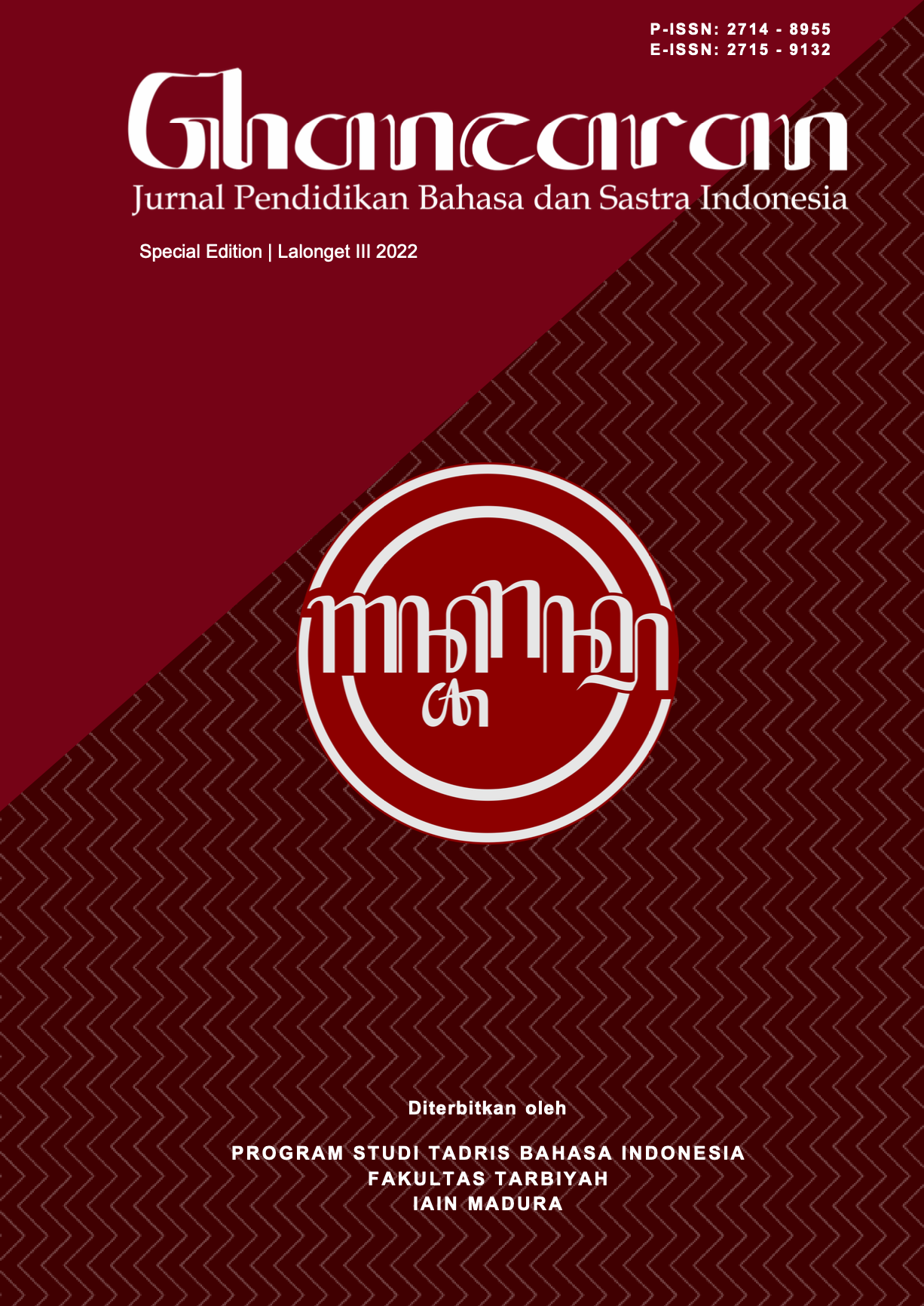Cerita Rakyat Tokoh Gayatri Rajapatni sebagai Sarana Penguatan Profil Pelajar Pancasila Pada Siswa SMA
 Abstract views: 393
,
Abstract views: 393
,
 pdf downloads: 598
pdf downloads: 598
Abstract
Folklore is a variety of literary works that existed earlier than other literary works. Folklore developed from generation to generation. It can be from old stories to fibers or chronicles written by ancient masters or writers. The figure of Gayatri Rajapatni himself is the daughter of King Kertanegara of the Singosari Kingdom. The leadership of the Majapahit government at that time, Gayatri had the right to rule. In fact Gayatri chose to become a royal advisor. Character formation in students can be developed through the material in the learning process. It was Gayatri's figure that made the second era after Raden Wijaya a great empire because he had an agile and intelligent regent for his upbringing. The intelligent, feminine, and nationalist character of Gayatri Rajapatni can be used as character teaching materials by students. This study aims to introduce and utilize local folklore as a form of character education for students. Researchers used a qualitative descriptive approach by using literature review techniques. Researchers get data from the results of previous research collections, the youtube platform, and so on.
Downloads
References
Bhuvaneswari, K., Geethalakshmi, V., Lakshmanan, A., Srinivasan, R., & Sekhar, N. U. (2013). The impact of El Nino/ Southern Oscillation on hydrology and rice productivity in the Cauvery Basin, India: Application of the soil and water assessment tool. Weather and Climate Extremes, 2, 39-47.
Brennan, M. A., & Israel, G. D. (2008). The Power of Community. Community Development, 39(1), 82-97.
Channel, Asisi. 2022. Gayatri Rajapatni: Senjata Rahasia di Balik Kejayaan Majapahit. Diakses dari https://www.youtube.com/watch?v=UxJK1gDcUQM&t=112s.
Drake, Earl. (2012). Gayatri Rajapatni: Perempuan di Balik Kejayaan Majapahit. Yogyakarta: Penerbit Ombak.
Felisia, Putu. (2019). Putri Rajapatni. Jakarta: Loka Media.
Fitri, Agus Zaenal. (2012). Pendidikan Karakter Berbasis Nilai dan Etika diSekolah. Yogyakarta: Ar-Ruzz Media.
Gusal, La Ode. (2016). “Nilai-nilai Pendidikan dalam Cerita Rakyat Sulawesi Tenggara Karya La Ode Sidu”. Jurnal Humanika. 16 (1), 1-18.
Hamid A.R, 2014. “Pembelajaran Sejarah”. Yogyakarta: Penerbit Ombak.
Haryati, S. (2013). PENDIDIKAN KARAKTER DALAM KURIKULUM 2013 Oleh: Sri Haryati (FKIP-UTM). Pendidikan Karakter Dalam Kurikulum 2013, 19(2), 259–268.
Hasan, S. H. (2019). Pendidikan Sejarah untuk Kehidupan Abad Ke 21. HISTORIA: Jurnal Pendidik Dan Peneliti Sejarah, II(2), 61–72.
Kemendiknas. (2011). Desain Induk Pendidikan Karakter.Jakarta: Kementerian Pendidikan Nasional.
Kontu, F. (2017). Representasi Perempuan dalam Kebijakan Publik di Era Otonomi Daerah. Societas, 6(01), 34–46.
Maftukhin, dkk. (2018). Melacak Jejak Spiritualitas Bhinneka Tunggal Ika dan Visi Penyatuan Nusantara. Tulungagung: Akademia Pustaka.
Moraletat, E. (2020). Perempuan, Negara, dan Keluarga. Yogyakarta: Liberta.
Musdah, Mulia. (2014). Indahnya Islam Menyuarakan Kesetaraan dan keadilan Gender. Yogyakarta: Nauvan Pustaka.
Poerwanti, Endang. (2011). Meretas Nilai – Nilai Moral dalam Naskah Wulangreh dan Wedhatama. Skripsi. Universitas Widya Dharma.
Prastowo. (2011). Metode Penelitian Kualitatif. Yogyakarta : Ar-Ruzz Media.
Putikadyanto, Agus Purnomo Ahmad, Gamal Kusuma Zamahsari, & Mohammad Thoha. (2022). A Bibliometric Analysis of Digital Game-Based Language Learning to Support Future Language Learning. 7th International Conference on Sustainable Information Engineering and Technology 2022, 207-211.
Putri, R. (2018). Dari Sraddha ke Sadran. Diakses dari https://historia.id/amp/kuno/articles/dari-sraddha-kesadran-P140g.
Pranidhi, D., Santoso, W. M., & Siscawati, M. (2022). Otoritas Perempuan dan Religiusitas Gayatri Rajapatni. Dharmasmrti: Jurnal Ilmu Agama Dan Kebudayaan, 22(1), 1–8.
Suhra, S. (2019). Potret Perempuan Dalamranah Politik Di Indonesia. An-Nisa, 11(1), 335–344. https://doi.org/10.30863/an.v11i1.300.
Sumarwati. (2015). The Traditional Dhukutan Ceremony in Tawangmangu, Karanganyar Regency, Indonesia. International Indonesian Forum. 7, 4.
Sutrisno, I. H. (2018) “Makna Sumpah Palapa Bagi Nusantara (Kajian Ekspedisi Pamalayu Dalam Konsep Nasionalisme Majapahit),” Seuneubok Lada: Jurnal Ilmu-ilmu Sejarah, Sosial, Budaya dan Kependidikan, 5(1), hal. 7-15.
Soerono, A. S. (2014). Jayaning Majapahit: Kisah Para Kesatria Penjaga Samudra. Jakarta: Gramedia Pustaka Utama.
Tim Penyusun. (2014). Inspirasi Majapahit. Yogyakarta: Yayasan Arsari Djojohadikusumo bekerja sama dengan Universitas Indonesia, Universitas Gadjah Mada, Universitas Udayana dan Universitas Hasanuddin.
Turner, G. (1999). Film as Social Practice. New York: Routledge.
Undang-Undang Republik Indonesia Nomor 20 Tahun 2003.
Wahyudi, D. Y. (2013). Gayatri Dalam Sejarah Singhasari Dan Majapahit. Jurnal Sejarah Dan Budaya, 7(2), 16–21. http://journal.um.ac.id/index.php/sejarah-dan-budaya/article/view/4743
Copyright (c) 2022 GHANCARAN: Jurnal Pendidikan Bahasa dan Sastra Indonesia

This work is licensed under a Creative Commons Attribution-ShareAlike 4.0 International License.
Ghancaran: Jurnal Pendidikan Bahasa dan Sastra Indonesia uses an Open Access Policy under the Creative Commons Attribution-ShareAlike 4.0 International License. Authors publishing in this journal agree to the following terms:
- Ghancaran Journal holds the copyright and grants the journal rights for first publication with the work simultaneously licensed under a

The work is distributed under Creative Commons Attribution-ShareAlike 4.0 International License which allows others to share, copy, and redistribute the material in any media or format and adapt, remix, change, and develop the material even for commercial purposes, as long as it is stated credit and license derivative works under similar terms. - Authors may make additional contractual arrangements for non-exclusive distribution of the journal's published work version.
- Authors are permitted to post their work online (e.g., in institutional repositories or on their websites) before and during submission, as doing so may lead to productive exchange.



















